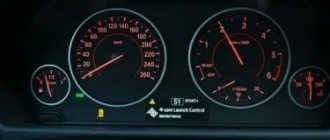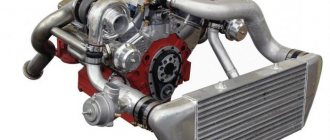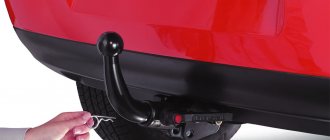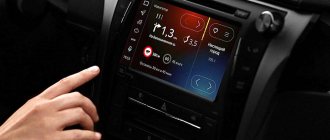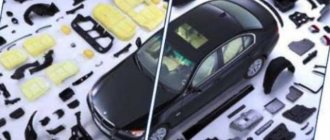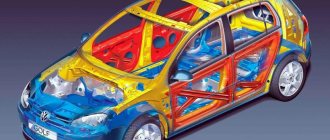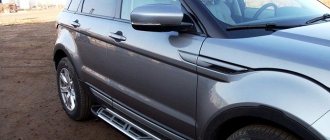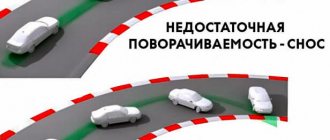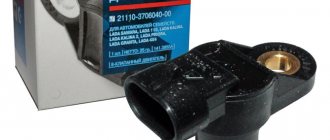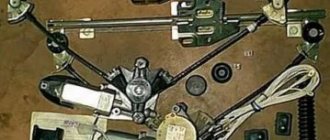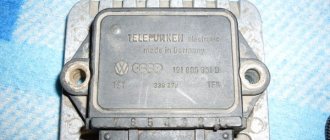Long car trips become a real challenge for many drivers. Fatigue and stress behind the wheel turn a long-awaited family vacation into a painful wait for peace. A real salvation is having cruise control in your car. The device, invented in the 50s of the last century in the USA, gradually gained popularity throughout the world. However, not everyone knows what cruise control is.
Cruise control is a special device in a car that is capable of maintaining a set speed without the driver’s intervention by automatically pressing the gas pedal in case of a decrease in speed, as well as an increase in speed on descents. It is most convenient to use cruise control when traveling long distances, since in urban environments drivers are rarely able to travel at a constant speed.
How does he work?
The cruise control system controls your vehicle's speed the same way you control your pressure on the gas pedal. However, cruise control clamps the throttle valve using a cable connected to the actuator, rather than by pressing the pedal. The throttle valve controls the power and speed of the engine, limiting the amount of air it consumes (since it is an internal combustion engine). The driver can set cruise control using cruise switches , which typically contain:
- On
- Off
- Set/Accel
- Coast (reduce speed)
- Resume
They are usually located on the steering wheel or turn signal lever. The SET control sets the vehicle speed. One press will speed it up by 1 km/h, two by 2 km/h and so on. Pushing the handle in the opposite direction will reduce the speed. As a safety feature, the cruise control system is disabled when the brake pedal is pressed.
However, with more cars on the road, the functionality of conventional cruise control is becoming obsolete. Adaptive cruise control is quickly gaining popularity and for good reason!
Adaptive cruise control is the next big step in terms of automatic speed control in new cars. This is an intelligent form of cruise control that slows down and accelerates automatically to keep up with the car in front.
...and disable the traffic control system
This problem is solved in different ways: in some foreign cars it is enough to press the brake pedal, and the car will automatically switch to manual control mode, in other cars you need to press a special lever or button. In addition, if the vehicle has an automatic transmission, then to cancel the motion control function, the lever must be moved to neutral.
IMPORTANT!
If the asphalt on a suburban highway is icy, it is raining heavily, or driving in poor visibility conditions, it is not recommended to turn on cruise control!
How does adaptive cruise control work?
The driver sets the maximum speed, similar to what can be done with conventional cruise control. A radar sensor located at the front of the vehicle detects movement ahead of it and monitors the vehicle from the front. This sensor then controls the speed of your car so that you are always 2-3 seconds ahead of the car ahead.
Using input from radar sensors, the computer unit measures the distance to the vehicle in front and calculates the speed based on this. If there are several cars in the sensor's coverage field at the same time, it automatically selects which car the system should track.
In particular, if you approach a slower or stationary vehicle, adaptive cruise control will apply the brakes to the vehicle, triggering adjustments in the engine management system and, if necessary, the braking system.
ACC is very conscientious when it comes to security. If you are driving too close to the car in front, it will warn you in two stages. First, it will warn you with visual and acoustic signals, followed by a short brake application. If necessary, the system will bring your vehicle to a complete stop.
Some devices use a laser, while others use an optical system based on stereoscopic cameras.
Regardless of the technology, ACC works day or night, but its capabilities are hampered by extreme conditions such as heavy rain, fog or snow.
Passive cruise control
There are two types of cruise control: passive and adaptive. Passive cruise control is a simple system that is capable of maintaining only a given speed limit. It usually consists of a control unit, several sensors and a throttle valve drive.
The passive system works quite simply - when the driver reaches a speed that he considers optimal, he turns on the cruise control. The electronic unit uses sensors to record the speed mode and throttle position. When driving conditions change (ascent, descent), the sensors signal this, and the control unit sends a signal to the throttle valve actuator, which carries out the necessary actions with the throttle (opens, closes) to maintain the set speed mode.
Future Application of ACC
A few years ago, Google launched its self-driving car, which relies entirely on autonomous cruise control technology.
Google's self-driving car
This car has a total of eight sensors. Most notable is the Rotating Roof Lidar, a camera that uses an array of 32 or 64 lasers to measure the distance to objects to create a 3D map up to 200m away, allowing the car to analyze potential hazards.
Pros and cons of cruise control
In general, this system has virtually no disadvantages. Even the simplest passive cruise in a car can significantly increase comfort and reduce overall driver fatigue. The basic rule is to keep your hands on the steering wheel, as the system will turn off.
If we talk about the minuses, the main drawback is that in the city the cruise control is practically useless. The fact is that a car in such conditions usually moves at a low and constantly changing speed. In this case, the cruise on the car immediately turns off when you press the brake, which happens all the time when driving within the city. Also, the system is not active at speeds less than 30-40 km/h.
We also recommend reading the article on how to install a keyless engine start button with your own hands. From this article you will learn about the features of selecting and installing a start-stop button in a car.
It turns out that high-quality solutions to improve safety on the highway simply do not work in the city. For this reason, the presence of cruise control in cars that move exclusively around the city does not give the driver any special advantages.
There have also been cases where the marking-based system does not work properly on roads where the markings are weak or absent (which is quite common on CIS roads). In this case, the driver is not able to fully use all the advantages of modern cruise control in the mode of monitoring markings and road signs.
Some benefits of using the cruise control function
- Cruise control improves driving comfort
You can comfortably go on long rides without straining your legs to keep them in one position for a long time. With cruise control on, you can sit with your right leg relaxed and control your vehicle.
- Cruise control controls speed better
If you like to accelerate, the cruise control function can be your best friend. Activate this feature to maintain top speed and avoid speeding tickets.
- Cruise control can reduce fuel consumption
Maintaining a constant speed can help you save fuel. Most drivers are quite inconsistent in maintaining a given speed; constantly slowing down and accelerating will use more fuel than driving at a constant speed.
What is cruise control in a car?
A car's cruise control is a device that automatically controls the throttle, thereby increasing or decreasing the throttle. Once the driver selects a certain driving speed, the system controls the throttle independently.
This option is useful both in terms of comfort and safety. For example, by choosing a speed of 85-90 km/h (taking into account the highway limit of up to 90 km/h), the system will not allow the car to accelerate faster.
However, that's not all. Cruise control can also reduce the speed on descents, slow down the car when approaching another car that is moving at a lower speed, etc. Then, if no interference is detected, the vehicle returns to the set speed.
What is a cruise function for a car?
Cruise control, which comes from the English phrase “Cruise control,” is a device in the form of sensors and a logical block that determines the amount of throttle valve opening using a special cable. The device maintains a constant vehicle speed in passive mode until the limiting conditions are violated. The entire process is performed without the driver's participation, as if he were keeping the gas pedal pressed all the time.
Such a service is in demand during long hauls over long distances, when holding the gas pedal in the same position is not very comfortable.
Passive cruise function is installed on vehicles with an automatic transmission and on “mechanics”.
Adaptive Cruise Control (ACC) also monitors the distance to the vehicle in front, maintaining it at a set value. This semi-intelligent device operates in “follow” mode, provided that the set speed of the vehicle with ACC is higher than the speed of the vehicle in front. When approaching, the device is able to engage the braking system, keeping the cruise function turned on until a certain speed reduction threshold (usually 40 km/h).
Some ACCs also feature Hill Launch Assist (HLA).
ACC depends on the vehicle's safety systems ABS and ESP. If any of them is faulty, the ACC is switched off (warning signal on the display: ACC cancel disabled).
Adaptive control cannot replace the driver, since it may make mistakes/misunderstand, for example, when overtaking or changing lanes in front, the actions and speed of the car in front. Another example is when the traffic ahead is only partially blocking the lane of your car with adaptive cruise function. Therefore, the driver should always monitor the operation of the cruise control and not lose attention to the road.
What are the advantages of cruising?
What's most tiring is long road trips over long distances. This is where they come into their own:
- overvoltage;
- increasing fatigue;
- “blurring” effect on the eyes.
The same negative point includes the need to constantly keep your foot on the gas pedal. Here, except for cruise control, no one will come to the rescue.
The device was created in the middle of the last century precisely for this purpose. This reduced the load on the driver. The adaptive cruise system allows you to do even more: by pressing a special button, you can slightly increase or decrease the speed. The step of such a function is usually 1-2 km/h.
The number of presses determines the deceleration to a special cut-off point, or the acceleration of the car. There are also devices on the market that can monitor the speed of other vehicles in traffic. They maintain a safe distance between your car and the car in front.
This development expands the boundaries of control, allowing you to adjust the permissible speed and distance. You can always buy various types of cruise control devices in our online store DoCar.ru. As well as receive comprehensive advice on the specifics of using devices on a specific vehicle.
